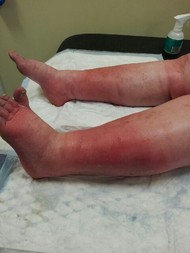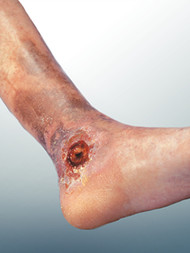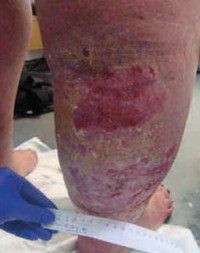Awareness
Complications

Cellulitis

Ulceration

Lymphorrhea
The Burden of Wounds
A recent research study has estimated that the annual cost of managing wounds in the NHS and associated comorbidities is £5.3 billion. This is comparable to the £5 billion spent on managing obesity in the NHS. Over a year, approximately 4.5% or 2.2 million people of the UK adult population will have a wound and about 30% of wounds in this study lacked a diagnosis documented in the GP records. In the UK most wounds are managed largely in the community by GPs and more commonly by nurses.
The most commonly treated wounds are leg ulcers. Leg ulcers are chronic wounds that occur in the lower leg; they are distressing and painful to those who have them, prone to infection and have a negative impact upon a patient’s mobility and quality of life.
1.5% of the UK population (with wounds) are estimated to have a leg ulcer and 19% of the leg ulcers in this research study were not characterised. To ensure the most appropriate treatment, the ‘character’ of leg ulcers needs to be diagnosed to determine the predominant cause, such as venous, arterial or mixed aetiology.
Improved wound care including effective assessment, diagnosis, treatment and prevention of wound care complications can minimise treatment costs and importantly improve outcomes and experience for people with a wound.
Reference: NHS RightCare scenario: The variation between sub-optimal and optimal pathways, England NHS UK [Online], accessed April 2018, https://www.england.nhs.uk/rightcare/wp-content/uploads/sites/40/2017/01/nhs-rightcare-bettys-story-narrative-full.pdf,
Meet Betty
The story of Betty's experience of having a leg ulcer, and how it could be improved... click here to read the NHS RightCare scenario.
A Target to Aim For
A national CQUIN target has been implemented to improve outcomes for patients with wounds. Please click here to read more.
Tools
Best Practice Statement for Chronic Oedema
Lymphoedema Clinical Manifestations Factsheet
Why do we need to be looking after legs?
Conditions which may lead to swelling of the lower limb are becoming more prevalent. Statistics and current demographic trends indicate that chronic oedema and chronic venous disease are a growing health care problem. These conditions are often progressive and can have a significant impact on the patient and the NHS.
Swelling can be a result of:
- Venous insufficiency
- Lymphatic insufficiency
- Not elevating the lower limb (dependant oedema)
- Cardiac failure
- Renal failure
Swelling is a common symptom of chronic venous disease. Symptoms also include varicose veins and leg ulceration. Chronic oedema is a term used to describe a swelling that has been present for three months or more.



